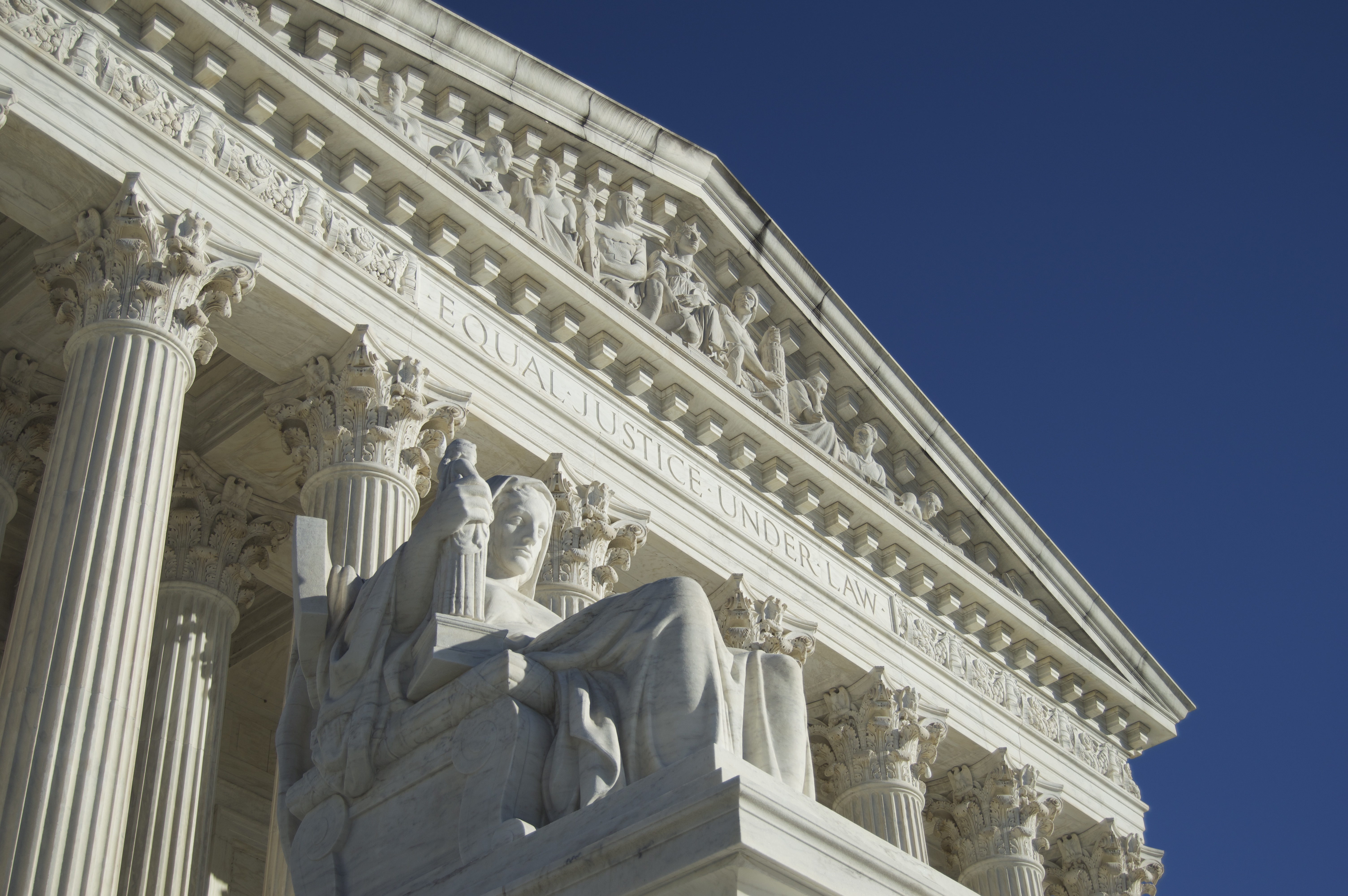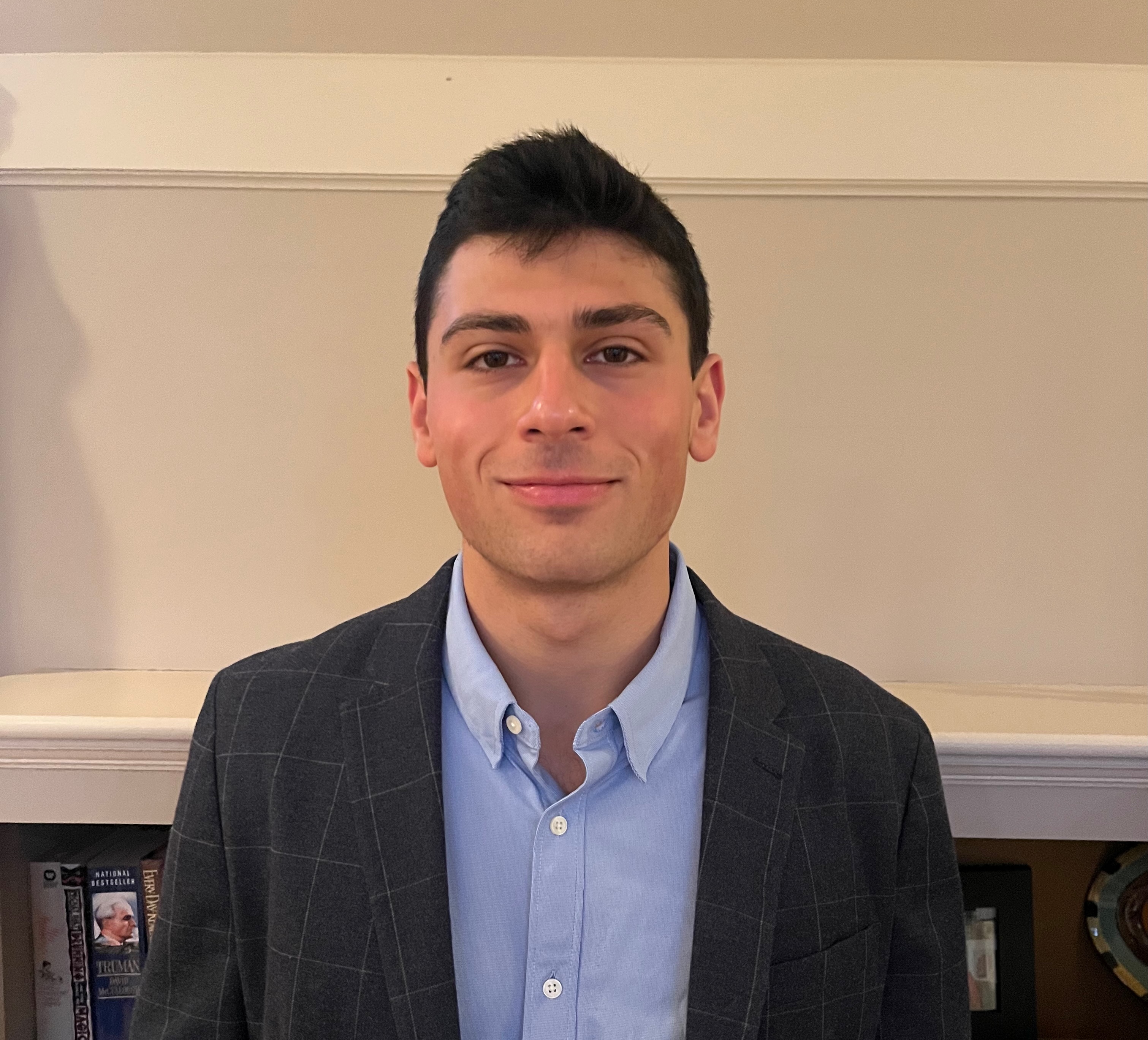Trump v. Anderson: SCOTUS Hears Trump Disqualification Arguments

Published by The Lawfare Institute
in Cooperation With

On the morning of oral arguments in Trump v. Anderson, the appeal of the Colorado Supreme Court’s explosive decision kicking former president Donald Trump off the presidential primary ballot in the state for his role in the Jan. 6 insurrection, First Street is dappled with broadcast setups and TV correspondents. Many are live streaming from the front of the Court to a public eager to know about a case that will determine whether the current Republican favorite is able to continue running for president, or whether he disqualified himself by being a part of a violent attack on the Capitol and attempting to strongarm the counting of electoral votes three years ago.
The probable outcome of the case has long been assumed: Most commentators have always expected that the Supreme Court would not intervene in a presidential election, and wouldn’t be especially eager to affirm a decision taking former President Trump off the ballot. But in recent months, legal arguments arguing for the applicability of Section 3 of the 14th Amendment—the provision added to the Constitution after the Civil War that says, in relevant part, that “[n]o person shall…hold any office…under the United States” who “previously t[ook] an oath…as an officer of the United States…to support the Constitution of the United States” and then “engaged in insurrection,” except where that disability is removed by Congress by a vote of two-thirds in both chambers—have come from far and wide, from conservatives and liberals alike, and importantly from hardcore originalists. After Colorado, more challenges against Trump cropped up across the country. This created a certain momentum that made the case, at the very least, seem less obvious before the Court.
So for some observers trying to get a seat in the courtroom today, the question at the top of mind was not what the Court would ultimately decide, but rather, how the justices would get there. That’s why Paula Barbour said that she traveled all the way from Philadelphia, Tennessee to hear this case in person—a day after her birthday, no less. She says she knows that the Court won’t take Trump off the ballot. But she wants to see how the judges would approach the arguments: their questions, their “demeanor,” their rationales. Because in her mind, Trump is clearly disqualified.
“You can be a contortionist all you want and make it to be what you want, but I think the Constitution is clear,” she said.
That turned out to be pretty typical. Each of the people interviewed for this piece similarly said they were fully expecting the Court to keep Trump on the ballot, but wanted to see how such a decision came about. Notably, Trump supporters were hard to find in the public line, which reached over 100 people—many of them supported the respondents.
Eliza Carter, a student from Iowa who now attends George Washington University, said that she was here because she “heard that this was going to be the biggest case of [her] generation”—and because she wants to know how the Court would address it in light of what happened on Jan. 6.
“Personally, my definition of insurrection happened,” she said. “I get that there are legal arguments against taking him off the ballot. But practically speaking, we can’t just let this happen without consequences.”
The events of Jan. 6, however, turned out not to be what the Court wanted to discuss in any depth at oral argument. Indeed, only around halfway through the two-hour argument did the issue of the events of Jan. 6 even come up. Was Jan. 6 an insurrection? Did Trump “engage” in it? Is he protected by the First Amendment? These weren’t the questions the justices wanted to talk about.
Instead, the arguments focused on two questions: Does Section 3 even apply to Trump and the presidency? And do states have the power to enforce it without congressional action—especially against a presidential candidate?
The question about whether the president is an officer of the United States—or as Justice Kagan put it to the delight of the packed courtroom, “the officer stuff”—got a fair bit of time. The question of whether Section 3 requires congressional action dominated the day.
By the end of the session, two things were clear: Trump would not be removed from the Colorado ballot. And the justices would, perhaps in different ways, focus on the necessity of congressional action.
In this piece, we describe the attorneys’ arguments and what each justice focused on in questioning, and we analyze how the Court might go about writing an opinion that seems destined to keep Trump on the Colorado ballot and prevent other states from following its lead.
The Advocates
The first lawyer to present was Jonathan Mitchell, who represented former President Trump. A former Solicitor General for the state of Texas, Federalist Society mainstay, and one-time law clerk for the late Justice Antonin Scalia, Mitchell came to the present case with five prior Supreme Court arguments under his belt. This experience served him well, as he was measured, clear, and articulate throughout oral argument, even in addressing some of the more complicated hypotheticals put forward by the justices. He was frank about the textual and historical weaknesses in some of the arguments he was advancing on behalf of his client—a strategic move that was no doubt intended to earn him credibility with the Court and to guide them towards his preferred grounds for resolving the case, as he openly conceded.
It was a terrific performance.
Mitchell began by restating Trump’s main arguments, which have been something of a moving target throughout the course of the case. His leading contention was that Section 3 is not self-executing, but instead requires federal legislation from Congress before it can be enforced—a view Mitchell tied to Justice Salmon Chase’s 1869 circuit court decision in the matter of Griffin’s Case, though he conceded it was not binding precedent. While Congress had enacted such legislation in 1870, it has since been rescinded, leaving Section 3 otherwise unenforceable without congressional action. Secondarily, Mitchell also argued that Section 3 itself only addresses the eligibility to hold office, not run for it, and that Colorado could thus not use it to disqualify Trump from the ballot because, among other reasons, Congress could choose to rescind Trump’s ineligibility (or, in the words of Section 3, “remove the disability”) prior to his assuming office.
Later, at the urging of the justices, Mitchell also revisited some other arguments his client and those who filed amicus briefs on Trump’s behalf had put forward, including the much-discussed proposition that Section 3 does not apply to the presidency, either because the presidency does not constitute “[an] office…under the United States” from which Section 3 disqualifies impacted individuals—an argument Mitchell preserved but conceded was weaker, given the way similar language is used elsewhere in the Constitution—or because the president is not “an officer of the United States” whose oath can serve as a predicate for disqualification. He also confirmed that his client was not ready to concede that the events of Jan. 6 (or his participation in them) constituted an insurrection, even though Mitchell described them as “a riot” that was “criminal [and] shameful.”
Mitchell was followed by Jason Murray, the attorney for the respondents. A Denver-based public interest attorney, Murray is far younger and less experienced than Mitchell, but not without his own impressive credentials, including clerkships for Justice Elena Kagan and then-judge Neil Gorsuch during the now-justice’s time on the 10th Circuit. For his part, Murray opened by setting his sights on Trump’s interpretation of the “office” and “officer” language in Section 3, which he dismissed as a convoluted reading intended to create an exemption for Trump alone—a reference to the fact that Trump would possibly be the only former president not covered by Section 3 under his reading, as he is the only former president who has only taken an oath of office as president and never by virtue of holding any prior position in government. To the contrary, Murray argued that Section 3 deliberately used broad language to keep insurrectionists out of much of government, including the presidency, without requiring specific enforcement legislation. And by enforcing this disqualification and removing Trump from the ballot, the state of Colorado was simply exercising its constitutional prerogative not to waste its electoral votes on a candidate unable to hold office, just as states have done with other constitutional disqualifications in the past.
To his credit, Murray presented these arguments clearly and with confidence. But he quickly encountered an almost uniformly hostile bench, nearly every member of which pushed back hard on elements of his arguments and their potentially far-reaching consequences. His former employer Justice Gorsuch—whose nomination to the Court Murray had publicly supported, despite their stated political differences—was particularly sharp in his questioning, causing Murray to stumble on at least one occasion over the question of whether Trump’s immediate disqualification from office after Jan. 6 meant that military officers no longer needed to obey his orders.
The third advocate to speak was Shannon Stevenson, the solicitor general for the state of Colorado, who was representing Colorado Secretary of State Jena Griswold, another respondent in the case. A long-time private practitioner who took office less than a year ago, Stevenson was allotted a smaller share of argument time (nominally 10 minutes) to address the narrower set of issues specifically relevant to her client. Towards that end, she used her opening remarks to underscore Colorado’s position that it has the constitutional authority to choose to keep disqualified candidates off its ballots, including those disqualified under Section 3 who might later have their disability removed by Congress, and that the process Colorado used to do so in this case was well established and consistent with the Due Process Clause. In business-like fashion, Stevenson used her remaining time to respond to various hypotheticals posed by the justices and to walk them through aspects of state elections practice. In particular, she addressed concerns that a decision by Colorado could have far-reaching effects by virtue of collateral estoppel, noting that this was true to some extent and was a feature, not a bug, of the decentralized, state-based system for managing elections. Perhaps because of the narrow focus of her argument—and the clarity with which she was able to address aspects of state election law—Stevenson was spared much of the skepticism that had been leveled against Murray, even over similar arguments.
Indeed, by the time Mitchell returned to the podium for his rebuttal, the justices seemed spent. He took the time to reiterate his main arguments before twisting the knife on the challenging point Justice Gorsuch had used to trip up Murray, specifically by arguing that Murray’s position would inevitably lead to legal challenges to every action former President Trump had pursued from Jan. 6 through the end of his time in office. When Mitchell closed by volunteering to address any last questions, no justice took him up on the opportunity.
What the Justices Asked
As often happens at oral arguments, some of the justices were relatively open books. Others were more Delphic. The following is a summary of the expressed concerns of each justice through his or her questions. What emerges is a clear majority skeptical of the power of a state to use its ballot access procedures to enforce Section 3—especially against candidates for federal office—in the absence of some legislative sanction from Congress.
Justice Clarence Thomas
As the most senior member of the Court, Justice Clarence Thomas opened each round of questioning. For each, after a few targeted inquiries, he was generally content to revert to his usual taciturn posture and leave the rest of the questions to his colleagues. For Mitchell, Justice Thomas only asked whether Section 3 is self-executing, which opened the way for Mitchell to more fully articulate his argument that Congress must implement Section 3 through legislation, as suggested in Griffin’s Case.
Murray received a more intensive line of questioning focused on the historical use of Section 3 to disqualify candidates from office. Thomas first asked Murray whether he was aware of examples around the time of the passage of the Fourteenth Amendment when states disqualified candidates for national offices. He did not appear persuaded by Murray’s answer that, although he had just one example—the governor of Georgia declining to certify the election of one member of Congress in 1868—the fact that states did not use printed ballots back then explains the lack of additional disqualifications. Justice Thomas countered that there were many ex-confederates who could have served in national positions, and that if political actors viewed Section 3 as a viable means of removing candidates from national elections, that would have happened more than once. Justice Thomas also did not accept Murray’s claim that states excluded many candidates from state office, noting that, “What we are talking about here are national candidates.” Thomas’s questioning of Murray reflects a strong dose of skepticism concerning the use of Section 3 at least as it relates to the disqualification of federal officials by states.
Chief Justice John Roberts
Chief Justice John Roberts’s questions for Mitchell focused on a state’s ability to disqualify a candidate under Section 3 without additional qualifications added by Congress. Roberts asked if a state secretary of state could disqualify someone who approaches the secretary and admits to having sworn an oath and then engaging in an insurrection, to which Mitchell said no, as that would be altering the Constitution’s qualifications for the presidency.
But in his exchange with Murray, Roberts took a step further back to consider structural constitutional issues—and the, in his view, potentially harmful implications of siding with Colorado. Roberts noted that the fundamental purpose of the Fourteenth Amendment was to restrict state power and expand federal power. Would it not turn the amendment on its head, he posited, for the amendment to enable a state to remove a candidate from the federal election?
Roberts also predicted that, if the Court were to affirm, certain states would begin disqualifying Democratic candidates, too, and “[I]t'll come down to just a handful of states that are going to decide the presidential election.” Roberts thought the breadth of the term “insurrection” made such a scenario likely, and he appeared not to relish the prospect of the Supreme Court having to officiate these disputes.
Roberts also asked Stevenson whether the Court should conduct a de novo review of the case (reexamining the factual findings), and without that review, whether the Court could still reach a different result. Stevenson said the Court should not undertake de novo review, but that it would be possible, in theory, for the Court to reject the Colorado Supreme Court’s ruling without de novo review.
Justice Samuel Alito
For his part, Justice Samuel Alito appeared similarly concerned—perhaps more than any other justice—with what he views as the dangerous consequences that could flow from allowing Colorado to bar Trump from the state’s ballot. Two possibilities in particular seemed to irk him: first, that Colorado’s actions may effectively settle the case for the whole country; and second, that different states, relying on different judicial procedures and standards, could alternately generate a precarious lack of uniformity across the country.
Alito teed up these concerns in a question to Mitchell in which he posited that, based on the doctrine of collateral estoppel—which, for the purposes of this case, may preclude relitigating Trump’s eligibility for the presidency—other states may be forced to accept Colorado’s conclusion.
But in his exchange with Murray, Justice Alito asked what the Court would do “if different states had adjudicated the question,” with “different rulings on the admissibility of evidence, perhaps different standards of proof.” After peppering Murray with questions about the fallout of this decision, Justice Alito asserted that the consequences of Murray’s argument for removing Trump will involve “conflicts in decisions among the states.” This concern carried over to his questioning of Colorado solicitor general Shannon Stevenson, whom he prodded as to whether the Court should be concerned about a potential “cascading effect” of a trial judge’s decision of who can run for president, and the possibility that certain states may retaliate following one state’s decision to remove a certain candidate from its ballot. Stevenson’s response was that the Electors’ Clause assumes some level of “messiness of federalism,” and that the Court should allow that to play out—and that Congress can intervene “if it thinks that it’s truly federalism run amok.”
On Griffin’s Case, Justice Alito appeared unconvinced by Murray’s argument that the reason there have been so few Section 3 disqualifications is that there have been no events like the riot at the Capitol on Jan. 6, 2021. Alito noted that there were no impeachments of presidents from Andrew Johnson’s to Bill Clinton’s, but that there have been three since then.
Justice Sonia Sotomayor
Justice Sotomayor appeared the most sympathetic to the Colorado voters’ arguments—and perhaps the only justice with any sympathy for them. She appeared skeptical of Mitchell’s interpretation of the non-self-executing nature of Section 3. Justice Sotomayor questioned the validity of Griffin’s Case as a precedent for the Supreme Court; she noted the history of states disqualifying individuals from state elections; and she labeled as a “gerrymandered” argument Mitchell’s suggestion that the president is not an officer of the United States.
Expressing skepticism about Trump’s position on the self-executing point, Justice Sotomayor asked Mitchell, “You want us to say that self-execution doesn’t mean what it generally means. You want us now to say it means that Congress must…require states to stop insurrectionists from taking office.….so this is a complete preemption in a way that’s very rare, isn’t it?”
With respect to Griffin’s Case, Justice Sotomayor noted that in addition to it not being a decision of the Court, Justice Chase reversed his view on the matter a few years later in the Davis case, where he “assumed that Jefferson Davis would be ineligible to hold any office, particularly the presidency.”
Justice Elena Kagan
Justice Elena Kagan’s first question challenged the basis of Mitchell’s argument: It was not, she said, a constitutional argument, but rather a statutory preemption argument, a “kind of combination of Griffin’s Case plus the way Congress acted after Griffin’s Case.” She later noted the tension that results from an interpretation wherein Section 3 can only be enforced by an act of Congress—which would require only a simple majority to enact—but can be lifted only with a two-thirds majority. When Mitchell acknowledged that scholars like William Baude and Michael Stokes Paulsen had pointed out that exact problem with Griffin’s Case, she joked, “then I must be right!”
Although Justice Kagan did not appear convinced by part of Mitchell’s “officer of the United States” argument, she seemed to focus most intently on the federalism implications of affirming the Colorado Supreme Court’s decision. Justice Kagan noted in a question to Mitchell that especially in light of the lack of contemporaneous historical support for distinguishing the presidency from other officers of the United States, it would seem that “there’s no particular reason” prudentially to take this view, and that “you can think of lots of reasons for the contrary.” Justice Kagan continued, “is there any better reason for saying that an insurrectionist cannot hold the whole panoply of offices in the United States, but we’re perfectly fine with that insurrectionist being president?”
Justice Kagan also pushed Stevenson on whether Section 3 is equivalent to other forms of constitutional disqualification—in light of its placement in the Fourteenth Amendment, which did not empower states, but instead took power away from them. Section 3 gives Congress a concrete role; and “it’s just more complicated and more contested, and, if you want, more political” than other qualification rules in the Constitution.
But what appeared to be Justice Kagan’s broader, and more fundamental view of the case came out of her exchange with Murray. She asked whether a single state should have the agency to decide, in Justice Kagan’s words, what seems to be an “awfully national” question: “I think that the question that you have to confront is why a single state should decide who gets to be president of the United States,” she said. Justice Kagan asserted that it seems as though the means to enforce this provision should be a “federal, national means,” not a mere state means. Additionally, Justice Kagan pointed out that the Court has placed limits on the decisions of states that have consequences beyond their borders, and asked Murray why the Court should not do that here. Perhaps most directly, Justice Kagan stated at one point, “there are certain national questions…where states are not the repository of authority.”
Justice Neil Gorsuch
Justice Neil Gorsuch focused on two issues during the oral arguments: whether the president is an “officer of the United States” and the authority of a president deemed to have engaged in an insurrection before adjudication of this issue. Justice Gorsuch opened his exchange with Mitchell with the observation that much of Trump’s argument “hinges on the difference between…the term ‘office’ and ‘officer,’” asking Mitchell to describe the basis for that distinction in terms of “original understanding” and the text of the Constitution.
After continuing to drill into the details of this distinction in his questions for Mitchell, Justice Gorsuch returned to the issue later on with Murray, inquiring, “maybe the Constitution to us today…might look a little odd in distinguishing between ‘office’ and ‘officer,’ not prepositions, nouns, a distinction. But maybe that’s exactly how it works.” Further clarifying his position, Justice Gorsuch noted, “there are some instances when you have an officer but not an office.”
Perhaps the most contentious moment of the oral arguments came in a back-and-forth between Justice Gorsuch and his former clerk, Murray. Justice Gorsuch asked Murray why, if Section 3 is self-executing, military officers or other officials would need to obey a president they believe had engaged in an insurrection under the meaning of the Fourteenth Amendment.
After Murray said there has to be some procedure that disqualifies the president, Gorsuch asked, “On what theory?...You say he is disqualified from holding office from the moment it happens.” Murray’s responses did not appear to change Gorsuch’s view that if the Court were to affirm the decision, it may open the question of whether Trump was really president for the period between Jan. 6 and Biden’s swearing in and whether his actions during that period had any legal effect.
Justice Brett Kavanaugh
Justice Brett Kavanaugh was the most energetic advocate on the Court for looking to Griffin’s Case as a source of original public meaning of Section 3. Justice Kavanaugh’s questions focused on understanding precisely how Griffin’s Case figures into Mitchell’s argument, and whether, if the Court accepts Griffin’s Case as guiding, that would resolve the matter altogether. Justice Kavanaugh expressed the view that Griffin’s Case represents something close to the original public meaning of Section 3, since it came barely a year after enactment of the amendment’s ratification and Congress enacted legislation the year after Griffin’s Case was decided in response to it. He stated his views most clearly in response to Murray’s assertion that the reason Section 3 has not been used for 150 years is that insurrection is such a high bar, one that has not been met since the Civil War: “I think the reason it’s been dormant is because there’s been a settled understand that Chief Justice Chase, even if not right in every detail, was essentially right, and the branches of the government have acted under that settled understanding for 155 years.”
Justice Kavanaugh expressed additional concerns about the Colorado voters’ position with respect to the due process afforded to former President Trump and the broader democratic implications of affirming the Colorado Supreme Court’s ruling. In his final question, Justice Kavanaugh noted that Murray’s argument “has the effect of disenfranchising voters to a significant degree,” and Kavanaugh asked Murray to consider the “background principle…of democracy.”
Justice Amy Coney Barrett
Justice Amy Coney Barrett’s position was harder to read than those of her colleagues. She expressed concerns about the implications of a decision by the Court that Section 3 is self-executing, which would leave disqualification determinations completely up to the states. Building on the concerns flagged by Justice Kagan, she also expressed concern about Colorado deciding for the nation who was eligible to be president. In an exchange with Justice Kagan, Murray contended that it is the Supreme Court, not the state of Colorado, that would be the ultimate decider of this national question. However, Justice Barrett pointed out that the Supreme Court is largely “stuck” with the factual record established by Colorado, as the Court must review that record with “clear error” review. Therefore, the Court has very little authority here over what Justice Barrett views as a fundamentally national question.
In addition to this federalism concern, Justice Barrett sought to clarify a few other arguments set forth by Mitchell and Murray. She asked Mitchell whether his claim that Colorado has effectively added a disqualification provision to the Constitution means that Congress also could not enact a statute disqualifying a candidate from the ballot and whether former President Trump has due process rights at stake; Justice Barrett confirmed with Murray that his argument rests completely on states’ authority under the Electors’ Clause of the Constitution; and she asked Stevenson whether different procedures used in different states would require the Court to employ varying standards of review.
Justice Ketanji Brown Jackson
The Court’s most junior justice in some respects proved to be the most surprising. Some observers might have expected Justice Ketanji Brown Jackson, the only Biden appointee currently on the Court and one who fashions herself something of a Fourteenth Amendment originalist, to have been among the most receptive to the idea that Trump’s actions on Jan. 6 had disqualified himself from office. But those observers would have been dead wrong. To the contrary, Jackson’s questions suggested that she was openly skeptical of the idea and concerned about some of the potential consequences.
While she touched on a number of issues, Jackson’s most notable line of questioning to both Mitchell and Murray focused on a somewhat streamlined version of Trump’s contention that Section 3 does not reach the presidency: Why was the presidency, of all the offices in the federal government, omitted from the list of offices presented in the text of Section 3? She questioned why the Trump camp wasn’t relying more heavily on this argument.
Citing the historical record, Jackson posited that the choice to exclude the presidency from the list of offices an insurrectionist could not hold might have been a deliberate choice by the amendment’s authors, who were more worried about Confederate infiltration in state government than in the highest levels of power in the federal government. Ironically, neither counsel took her up on this suggestion: Mitchell noted that other parts of the historical record cut the opposite direction, while Murray pointed out that the authors of Section 3 might have focused on only explicitly listing those offices who might not be covered by the umbrella term “any office…under the United States”—namely federal legislators and presidential electors. Whether Jackson was persuaded by these rebuttals is unclear, but she seemed to maintain that the omission of the presidency from Section 3’s text at least suggested ambiguity on whether it should be included within its scope at all.
Where Does the Court Go From Here?
With the possible exception of Justice Sotomayor, the justices seemed unified in their reluctance to uphold the Colorado Supreme Court’s conclusion that Trump should not appear on its state general election ballot. In terms of the case at hand, the writing seems on the wall: When the Supreme Court rules, former President Trump will not be disqualified from running for office, in Colorado or anywhere else—at least not unless Congress takes action.
But the justices were less obviously unified on why. The clearest center of gravity among the arguments presented seemed to be the Griffin’s Case argument advanced by Mitchell, which would hold that Section 3 can only be enforced pursuant to federal legislation. But some justices seemed just as persuaded that Section 3 itself does not reach the presidency. And some seemed attracted to the idea that it applied only to holding, not running for, federal office. Some also seemed concerned that Section 3 not be read as allowing Colorado alone to decide on the eligibility of candidates for federal office. Which if any of these arguments has five votes is far from clear after this morning.
This may or may not present a challenge for the Court as it works towards its final disposition of the case. Will the Court work towards unanimity on such a seminal (and politically charged) constitutional question, as Chief Justice Roberts has publicly urged in the past? Or will some of the justices feel the need to express their divergent views in separate concurrences (and perhaps a dissent or two)? Or will consensus prove beyond reach, resulting in a cacophony of opinions with overlapping arguments, some of which may or may not have five votes, that will be a point of debate in court briefs and law review articles for years to come?
The speed with which the court needs to resolve this case could make consensus either more or less likely, depending on the dynamics among the justices.
The stakes of this debate are high, even if the immediate outcome is not seriously in doubt. If the Supreme Court holds simply that states like Colorado cannot disqualify federal candidates—or that Section 3 only applies to the eligibility to hold office, not appear on a ballot as a candidate for it—then Trump’s disqualification from the presidency may still remain a live issue in federal court later in the election process or even after he assumes office. Perhaps more concerning, as election law expert Ned Foley and others have been warning for months (including in an amicus brief before the court), leaving questions about the substantive scope of Section 3 unresolved in this way may well put Congress itself in the difficult position of having to decide whether Trump is disqualified as it counts electoral votes on Jan. 6, 2025—a politically and constitutionally fraught scenario that may well be further complicated by the limitations that the recently adopted Electoral Count Reform Act imposes on that process, ironically in response to the events of Jan. 6, 2021. Only if the Court resolves the question of how to read Section 3 itself—by holding that Section 3 requires federal implementing legislation, for example, or that it does not apply to the presidency—will the issue be firmly settled in advance of the election. But whether the Court will resist its usual institutional inclination to avoid complex constitutional questions and get there is yet to be seen.
Adding to the complicated context for this decision is the fact that this matter now sits on a Supreme Court calendar that is crowded with other Trump-related items. As several of us wrote earlier this week, the D.C. Circuit recently rejected Trump’s argument that he is immune from criminal prosecution for events related to Jan. 6 in Trump v. United States and has set a hard deadline of Feb. 12 for Trump to petition the Supreme Court to stay the mandate and keep the trial court from proceeding. Trump also needs to file by Feb. 15 if he wishes to appeal the D.C. Circuit’s other immunity-related holding in Blassingame v. Trump, which similarly rejected his claim of civil immunity for Jan. 6-related conduct. One can envision a scenario in which a Court concerned about its public image in politically charged cases chooses to release them together, with Anderson holding in favor of Trump while the other two (where Trump is on far weaker ground) go against him.
At a minimum, today’s oral argument makes clear that nobody should expect the Supreme Court to solve the problem of a Trump return to power by keeping him off the ballot—in Colorado or anywhere else. That is clearly not going to happen.











